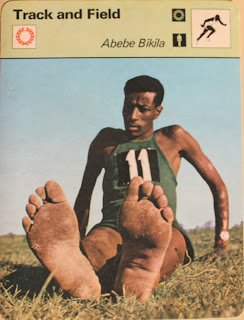So you read my post on Zola Budd, but you thought "sure, it's possible to run short distances barefoot on a track or cross-country course, but you still need shoes for long distances on hard surfaces." Well congratulations--you've just won the 100% wrong award.
 |
| Don't let it go to your head |
When Abebe was around the age of 20 he joined the Emperor's Imperial Bodyguard.
 |
| To be honest I just googled "imperial bodyguard"; I don't know if Abebe is in this picture or not |
In recent years Kenyan and Ethiopian distance runners have become so dominant that when a marathon is run nowadays most people simply assume that the winner will be some guy from eastern Africa, to the point that it has become a cliche.
Best nine seconds of silence ever
However, prior to 1960 no black African had won any Olympic medal in the marathon. As is still the case today, Ethiopia was an extraordinarily poor country, but unlike today there hadn't yet been an influx of modern coaching and corporate sponsorship from the west, so when Abebe arrived in Rome his sponsorship consisted of one pair of Adidas shoes (Adidas was the shoe sponsor for the Olympics that year). Abebe and the other Ethiopian (Abebe Wakjira) had always run barefoot but there was a concern that competing barefoot would reflect badly on the country, so the two decided to give the shoes a try before the race. The result wasn't pleasant--they both developed blisters after only 10 kilometers. Years later Wakjira recalled that having decided to race barefoot the two of them hid in the tent before the race because people were laughing at them.
 |
| Some things never change |
 |
| "Yes, this is very exciting, but have you seen my ship?" |
Having won Olympic gold in dramatic fashion and been suddenly thrust into the limelight from complete obscurity, Abebe may have seemed primed for a humiliating meltdown, but he returned to Ethiopia and quietly kept running, preparing for the 1964 Tokyo Olympics. By the time he arrived in Tokyo he was once again the underdog, owing to the fact that, one, his record had been beaten several times, and two, he had had an emergency appendectomy only a few weeks before and hadn't been able to run for the better part of a month. In fact, most people didn't expect him to start the race, let alone win it.
However, once the race began Abebe was back to his old self. Two hours and twelve minutes later, he had set another world record and become the first person to ever win two Olympic marathons. He apparently didn't have to work too hard doing it, either, because instead of collapsing with fatigue like the second and third place finishers, he immediately started doing calisthenics.
---------------------------------------------------------------------------------------------------------
Read more about Abebe Bikila in Part 2 of my post
---------------------------------------------------------------------------------------------------------

Order my children's book about barefoot running: What Should I Put on My Feet to Go Run?

Order my children's book about barefoot running: What Should I Put on My Feet to Go Run?




Excellent! Thanks.
ReplyDeleteOn Youtube you can find a video on Rome's victory:
http://www.youtube.com/watch?v=0Dppdcy1pyM
Thanks. That video is fantastic. I found some videos on youtube but somehow missed that one. He looked so effortless when he ran; it doesn't seem like he's running 5 minute miles. I also didn't realize how poorly lit part of the race was; the poor guy could have used a flashlight.
DeleteI got to school in East Mesa at ASU and have been running barefoot for the last 18 months. What are some tricks that you use when the weather gets really hot? Do you implement any treadmill work barefoot?
ReplyDeleteGreat blog!
The number one trick is to run early in the day, preferably before sunrise. Also, if you can find some dirt trails, natural surfaces don't heat up as much as cement and asphalt. I've never done much running on a treadmill barefoot (or at all, for that matter), though I know some people do.
Delete